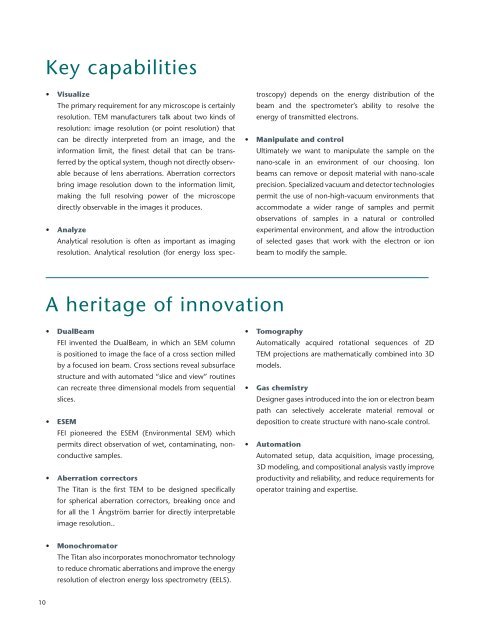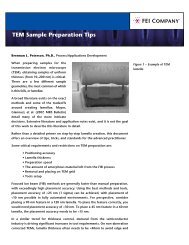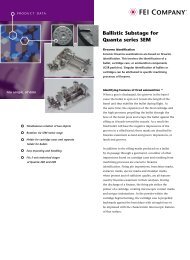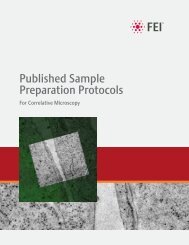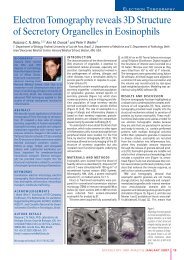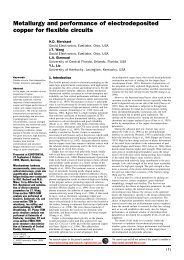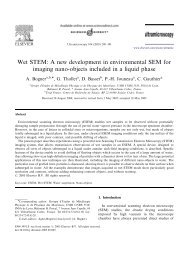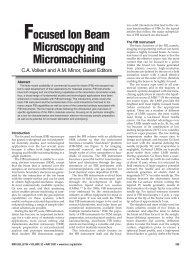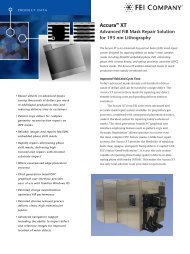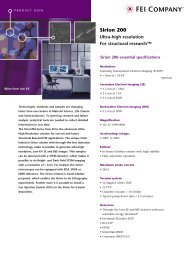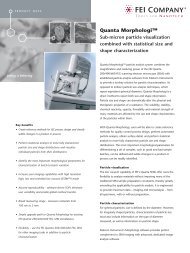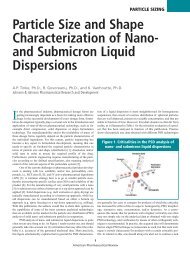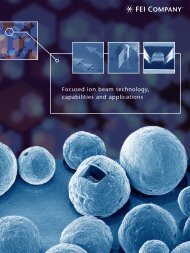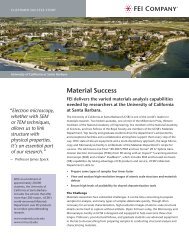Electron Microscopy Solutions for NanoResearch - FEI Company
Electron Microscopy Solutions for NanoResearch - FEI Company
Electron Microscopy Solutions for NanoResearch - FEI Company
You also want an ePaper? Increase the reach of your titles
YUMPU automatically turns print PDFs into web optimized ePapers that Google loves.
10<br />
Key capabilities<br />
• Visualize<br />
The primary requirement <strong>for</strong> any microscope is certainly<br />
resolution. TEM manufacturers talk about two kinds of<br />
resolution: image resolution (or point resolution) that<br />
can be directly interpreted from an image, and the<br />
in<strong>for</strong>mation limit, the finest detail that can be trans-<br />
ferred by the optical system, though not directly observ-<br />
able because of lens aberrations. Aberration correctors<br />
bring image resolution down to the in<strong>for</strong>mation limit,<br />
making the full resolving power of the microscope<br />
directly observable in the images it produces.<br />
• Analyze<br />
Analytical resolution is often as important as imaging<br />
resolution. Analytical resolution (<strong>for</strong> energy loss spec-<br />
A heritage of innovation<br />
• DualBeam<br />
<strong>FEI</strong> invented the DualBeam, in which an SEM column<br />
is positioned to image the face of a cross section milled<br />
by a focused ion beam. Cross sections reveal subsurface<br />
structure and with automated “slice and view” routines<br />
can recreate three dimensional models from sequential<br />
slices.<br />
• ESEM<br />
<strong>FEI</strong> pioneered the ESEM (Environmental SEM) which<br />
permits direct observation of wet, contaminating, non-<br />
conductive samples.<br />
• Aberration correctors<br />
The Titan is the first TEM to be designed specifically<br />
<strong>for</strong> spherical aberration correctors, breaking once and<br />
<strong>for</strong> all the 1 Ångström barrier <strong>for</strong> directly interpretable<br />
image resolution..<br />
• Monochromator<br />
The Titan also incorporates monochromator technology<br />
to reduce chromatic aberrations and improve the energy<br />
resolution of electron energy loss spectrometry (EELS).<br />
troscopy) depends on the energy distribution of the<br />
beam and the spectrometer’s ability to resolve the<br />
energy of transmitted electrons.<br />
• Manipulate and control<br />
Ultimately we want to manipulate the sample on the<br />
nano-scale in an environment of our choosing. Ion<br />
beams can remove or deposit material with nano-scale<br />
precision. Specialized vacuum and detector technologies<br />
permit the use of non-high-vacuum environments that<br />
accommodate a wider range of samples and permit<br />
observations of samples in a natural or controlled<br />
experimental environment, and allow the introduction<br />
of selected gases that work with the electron or ion<br />
beam to modify the sample.<br />
• Tomography<br />
Automatically acquired rotational sequences of 2D<br />
TEM projections are mathematically combined into 3D<br />
models.<br />
• Gas chemistry<br />
Designer gases introduced into the ion or electron beam<br />
path can selectively accelerate material removal or<br />
deposition to create structure with nano-scale control.<br />
• Automation<br />
Automated setup, data acquisition, image processing,<br />
3D modeling, and compositional analysis vastly improve<br />
productivity and reliability, and reduce requirements <strong>for</strong><br />
operator training and expertise.


